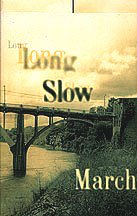 Long Slow March By Clifton Meador Purchase, New York: Center for Editions, Purchase College, 1996. 5.5 x 8.5"; 235 pages (unpaginated). Perfect bound hardcover in illustrated dust jacket. Photomontage. Offset printing. Type designed by the author. Johanna Drucker, in JAB 12: "History plays an important part in Meador's new works ... Long Slow March documents the history of African-American struggles for civil rights in the United States, taking the concept of narrative into the social domain where it creates both real and imagined histories of lived events. Meador uses photographs he made of the route of the famous march from Selma to Montgomery, Alabama, led by Martin Luther King in 1965 and other documentary material. He collages and splices his version of this history into a single book, but one that refuses to coalesce around a simple line. His identity as a Southern white man, raised in the era of the civil rights movement, is the point of departure for the work. There are no easy ways to tell historical tales, no singular perspectives from which to objectify the interwoven subjectivities that form our past." Clifton Meador, JAB 12: "Long Slow March weaves together multiple narratives focused on a theme: the African-Americans' struggle for civil rights. The Selma march (itself a narrative structure) forms the backbone of the book; the limbs of the book (primary source texts and photomontage of slavery and the civil rights struggle) hang on either side of it. The first section is a typographic lift of an old form, the polyglot bible. Polyglot bibles presented an original text in its original language, with commentary in translated languages surrounding it. This form seemed suitable for combing slave narratives with slave owners' rationalizations for slavery, since this typographic form preserves the autonomy of the texts while suggesting that the reader consider the texts together. "Having presented the history of the struggle (in warped abbreviated form) as a prelude to the central issue, the heart of the book is literally the road from Selma to Montgomery, photographed every mile or so. Title pages from slave narratives begin to hang in the air, floating overhead, witnesses to the march. Eventually, as the march (road) nears Montgomery, mainstream newspapers start publishing attacks on the march, on the participants in the march, and on the idea of civil rights. It was a shameful rearguard action on the part of people who should have known better; the evidence hangs in the air over the road. Using a shift in color to indicate a shift in narrative, images from the actual march in 1965, end the section of the book that addresses the march itself. Pictographic Klan warnings are knocked out of the documentary photographs, emblems of the persistent repression that impeded the struggle for civil rights. The last section of the book is a conflagration of all the forces and interests that collided over the civil rights struggle. "History itself is a confusing narrative, continually rewritten from the viewpoint of the reader." |